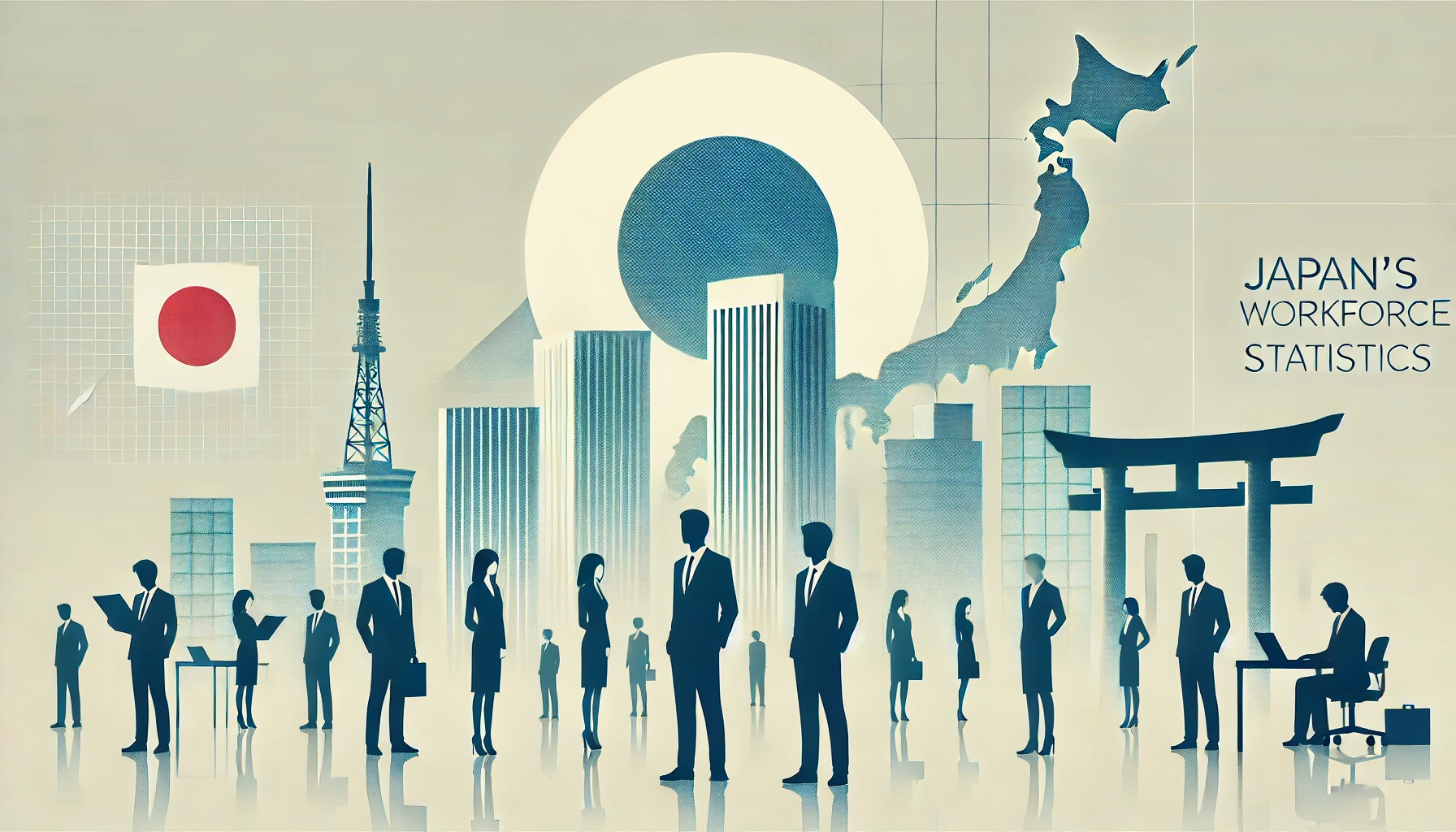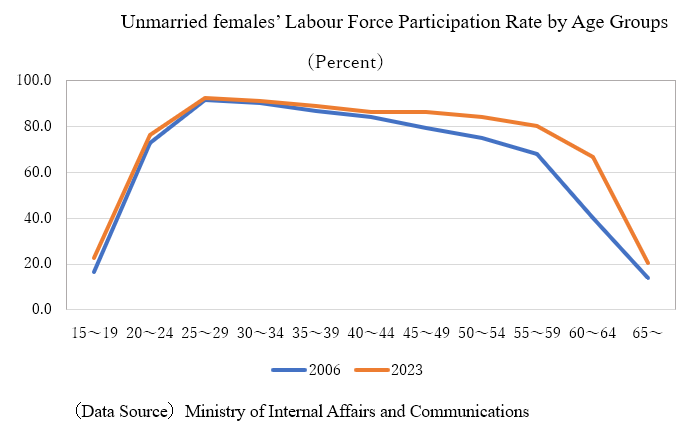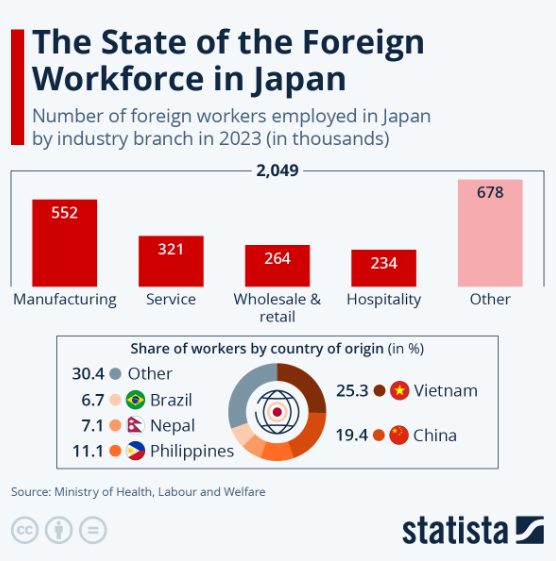Japan’s Workforce Statistics By Industry, Foreign Workforce And Employee Satisfaction
Updated · Sep 27, 2024

WHAT WE HAVE ON THIS PAGE
Introduction
Japan’s Workforce Statistics: Japan is one of the biggest economies in the world, with a strong focus on the automobile, technology, and innovation sectors. It’s a great place for business growth and an emerging market for outsourcing. In 2024, the average salary in Japan is 6,200,000 Japanese Yen (JPY), which is about $39,818 (based on the exchange rate in May 2024).
In this article, we will examine Japan’s Workforce Statistics and the factors that influence them. We will also discuss annual salary increases, the highest and lowest-paying jobs, and the country’s economic outlook.
Editor’s Choice
- The number of job vacancies dropped to 896,430 in February 2023, down from 899,870 in January.
- Japan Workforce Statistics forecasts that the number of employed people in Japan will increase by 0.3% from 2022 to 2023, reaching an estimated 67.54 million in 2023.
- According to Salary Explorer, monthly salaries in Japan range from ¥130,000 (starting salary) to around ¥2,300,000 (maximum average salary, although the actual maximum can be higher).
- The median monthly salary is ¥471,000, meaning half of the population earns less than this amount.
- The average monthly salary is ¥515,000, which equals an annual salary of ¥6,180,000.
- However, salaries can vary widely based on job type, experience level (entry-level, mid-level, executive), qualifications, and location.
- According to Japan’s Workforce Statistics, a software developer in Tokyo will earn about ¥4,402,832 in 2024, while a senior software engineer will make around ¥7,580,152.
- Japan’s unemployment rate was 2.4% in January 2023 but increased to 2.6% in February. This is still lower than the projected unemployment rate of 5.8%, which would represent about 208 million people in 2023.
- Full-time workers in Japan typically work 44.9 hours each week.
- Japan’s Workforce Statistics stated that about 20% of the workforce in Japan consists of irregular workers.
- The average age of workers in Japan is 44.4 years.
- Japan has a high percentage of elderly workers, with 7.6% of employees aged 65 and older.
- Women make up 53.5% of the labor force in Japan, as per Japan’s Workforce Statistics.
- Workers in Japan spend an average of 1 hour and 2 minutes commuting to work.
- Approximately 69.5% of employees take paid vacation days.
General Japan Workforce Statistics
(Reference: economy.com)
|
|
Reference | Last | Previous | Units | Frequency |
| Wage & Salaries | 2014 | 252,097,472 | 249,624,331 | Mil. JPY |
Annual |
|
Agriculture Employment |
2017 | 2,320,973 | 2,340,886 | # | Annual |
| Real Wages & Salaries | 2024 Q2 | 274,130 | 271,930 | Bil.Ch 2011 JPY, SAAR |
Quarterly |
|
Unemployment |
July 2024 | 2.7 | 2.5 | %, SA | Monthly |
| Unemployment | Jul 2024 | 187 | 176 | 10 Ths. #, SA |
Monthly |
|
Total Employment Non-Ag |
Jul 2024 | 6,598 | 6,622 | 10 Ths. #, NSA | Monthly |
| Total Employment | Jul 2024 | 6,766 | 6,786 | 10 Ths. #, SA |
Monthly |
|
Labor Force Employment |
Jul 2024 | 6,766 | 6,786 | 10 Ths. #, SA | Monthly |
| Labor Force | Jul 2024 | 6,954 | 6,963 | 10 Ths. #, SA |
Monthly |
- In Japan, the labor force participation rate dropped to 63.50% in July 2024, down from a peak of 63.70% in June, which was the highest since May 1999.
- According to Japan’s workforce statistics, the average participation rate has been 63.69% from 1953 to 2024.
- The highest rate ever recorded was 74.00% in June 1955, while the lowest was 58.50% in December 2012.
 (Source: tradingeconomics.com)
(Source: tradingeconomics.com)
| Jobs To Applications Ratio | 1.24 | 1.23 | Jul/24 | |
| Real Earnings, Including Bonuses | 0.4 | 1.1 | % |
Jul/24 |
|
Retirement Age Men |
64 | 64 | Years | Dec/24 |
| Overtime Pay YoY | -0.1 | 0.9 | % |
Jul/24 |
|
Real Earnings Excluding Bonuses |
0.4 | 1.1 | % | Jul/24 |
| Population | 124 | 125 | Million |
Dec/23 |
|
Retirement Age Women |
64 | 64 | Years | Dec/24 |
| Minimum Wages | 1054 | 1002 | JPY/Hour |
Oct/24 |
|
Wage Growth |
3.6 | 4.5 | % | Jul/24 |
| Wages in Manufacturing | 626687 | 621660 | JPY/Month |
Jul/24 |
|
Youth Unemployment Rate |
4.1 | 3.9 | % | Jul/24 |
| Productivity | 96.1 | 101 | points |
Jun/24 |
|
Job Vacancies |
817 | 828 | Thousand | Jul/24 |
| Wages | 459648 | 602589 | JPY/Month |
Jul/24 |
|
Part-Time Employment |
7579 | 7674 | Thousand | Jul/24 |
| Employment Rate | 61.8 | 62 | % |
Jul/24 |
|
Labor Force Participation Rate |
63.5 | 63.7 | % | Jul/24 |
| Employed Persons | 67660 | 67860 | Thousand |
Jul/24 |
|
Unemployed Persons |
1870 | 1760 | Thousand | Jul/24 |
| Full-Time Employment | 23613 | 23503 | Thousand |
Jul/24 |
|
Unemployment |
2.7 | 2.5 | % |
Jul/24 |
Labor Force Participation Rate
- The median yearly salary is about $38,515.
- Workers spend an average of 50 minutes commuting each way.
- Women retire on average at 64.8 years.
- Japan’s Workforce Statistics stated that around 69.9% of workers aged 55-64 are still active in the labor market.
- Employees work an average of 1,735 hours a year, more than the OECD average of 1,679 hours.
(Source: ceicdata.com)
- According to Japan’s Workforce Statistics, only 7.5% of managerial positions are held by women.
- The average retirement age is gradually rising and now stands at 70.0 years.
- 30% of workers feel overwhelmed and struggle to handle work demands.
- The rate of double-income houses has grown from 45% in 1991 to 56% in 2023.
- Japan has a high labor force participation rate of 71.4%, as per Japan’s Workforce Statistics.
- 67% of Japanese workers believe their company’s work culture negatively affects their health.
- 40% of workers have reported experiencing harassment or bullying at work.
- 4% of people aged 65-69 are still employed, as per Japan’s Workforce Statistics.
- The average retirement age in Japan is 66.9 years.
- Japan’s Workforce Statistics stated that around 26% of workers say they feel constantly tired due to work-related stress.
- Workers take an average of only 8.8 days of paid leave each year.

(Source: jcer.or.jp)
- Japan ranks 23rd out of 156 countries in the World Bank’s Human Capital Index, which assesses worker skills and health.
- Workers typically start receiving pension benefits at age 63.
- The retirement rate is declining, with many choosing to stay in the workforce longer.
- 56% of women leave their jobs after having their first child, contributing to the low female participation rate.
- 24% of workers feel pressured to work long hours because of cultural expectations.
- The average turnover rate for employees in Japan is 12.8%, as stated in Japan’s Workforce Statistics.
- The overall labor force participation rate is expected to drop due to an aging population.

(Source: jcer.or.jp)
- Japan ranks 21st out of 149 countries in the World Economic Forum’s Global Gender Gap Report.
- 54% of young workers feel their jobs need to use their skills fully.
- There is about a 19 %-point gap in labor force participation between men and women.
- Workers take an average of 8.8 days of paid vacation each year, as per Japan’s Workforce Statistics.
- 7% of workers feel pressured to work long hours to meet job expectations.
- The average retirement age for men is 69 years.
- Japan’s Workforce Statistics stated that almost 40.1% of workers aged 65-69 are employed.
- Japan’s Workforce Statistics stated that around 23.8% of workers report facing age discrimination in the workplace.
- The participation rate for those aged 55-64 is 67.6%.
- Japan ranks 5th in the world for female labor force participation, with 71.9% of women aged 15-64 working.
Labor Force Survey 2023 Yearly Median Statistics
- In 2023, the average number of employed people in Japan was 67.47 million, which is an increase of 240,000 from the previous year. This growth marks the third straight year of improvement.
- The number of regular employees rose by 180,000, while non-regular employees increased by 230,000.
- The overall employment rate was 61.2%, up by 0.1 percentage points. For men, the employment rate rose to 69.5%, an increase of 0.1 points, while for women, it increased to 53.6%, up by 0.6 points.
- In terms of industry, the accommodation and food services sector added 170,000 jobs, reaching 3.98 million.

(Source: weforum.com)
- The manufacturing sector gained 110,000 jobs, bringing its total to 10.55 million, and the information and communications industry increased by 60,000 jobs, totaling 2.78 million.
- On the other hand, the agriculture and forestry sector lost 50,000 jobs, totaling 1.87 million, according to Japan’s Workforce Statistics.
- The finance and insurance sector also saw a decrease of 50,000 jobs, bringing it down to 1.55 million.
- The education and learning support sector also lost 50,000 jobs, totaling 3.44 million, and other services (not classified elsewhere) decreased by 50,000 jobs, totaling 4.58 million.
- The average number of unemployed people was 1.78 million, down 10,000 from the previous year, and the average unemployment rate remained at 2.6%, unchanged from the previous year.
- In 2022, the job availability ratio was 1.31, which means there were 131 job openings for every 100 job seekers. This was an increase of 0.03 points from the previous year, showing improvement for the second consecutive year.

(Source: nippon.com)
- The labor market is tightening due to labor shortages as the economy continues to recover from the COVID-19 pandemic.
Employment
- In December 2023, there were 67.54 million employed people, which is an increase of 380,000 from the same month last year.
- This total included 36.85 million men (a decrease of 60,000) and 30.65 million women (an increase of 440,000) compared to the previous year.
Unemployment
- In December 2023, the number of unemployed individuals was 1.56 million, down by 20,000 from the same month the year before.
- The seasonally adjusted unemployment rate was 2.4%, down 0.1 percentage points from last December.
- The unemployment rate for men was 2.8%, up by 0.1 points, while for women, it was 2.0%, down by 0.4 points compared to the previous year.
Job Availability
- In December, Japan’s job availability ratio was 1.27, down by 0.01 from the previous month. This means there were 127 job openings for every 100 job seekers.
- According to Japan’s Workforce Statistics, the ratio of job offers for regular employees to applicants was 1.00, a decrease of 0.01 from the month before.
- The ratio of new job offers to applicants, an important sign for the labor market, stayed at 2.26, unchanged from the previous month.
- However, the number of new job offers dropped by 3.3% compared to the same month last year.
- In terms of industries, the education and learning support sector increased by 2.4%, while the manufacturing sector fell by 10.5%.
Family Income And Expenditure Statistics
Expenditures of Households (Two or More People)
- Average Monthly Spending**: $2,213.34
- Increased by 0.4% in nominal terms
- Decreased by 2.5% in real terms
- Trend: This is the tenth month in a row that real spending has dropped.
Income and Spending for Workers’ Households
- Average Monthly Income: $7,612.31 (including bonuses)
- Decreased by 4.4% in nominal terms
- Decreased by 7.2% in real terms
- Average Monthly Spending**: $2,590.57
- Decreased by 1.4% in nominal terms
- Decreased by 4.3% in real terms
- These numbers show how rising prices are affecting household incomes and expenditures, highlighting economic difficulties for families.
Distribution of Employment by Industry
- Industry Employment: More than 29% of Japanese workers are in the industrial sector.
- Ease of Doing Business: Japan ranks 30th out of 190 countries in the World Bank’s Ease of Doing Business Index.
- Overemployment: 12.8% of workers are over-employed, meaning they work more hours than they want.
- Union Membership: According to Japan’s Workforce Statistics, only 9.9% of workers are members of labor unions.
- Karoshi: There is a serious problem with karoshi (death from overwork), with around 190 deaths each year.
- Women in Leadership: Just 5.3% of executive roles are filled by women, and women hold 10.5% of leadership positions overall, which is lower than the global average of 31.3%.
 (Reference: researchgate.net)
(Reference: researchgate.net)
- Workplace Stress: According to a survey by the Ministry of Health, Labor, and Welfare, 80% of workers report feeling stressed at their jobs.
- Professional Services: 25.6% of employees work in professional, scientific, and technical services.
- Overtime Hours: The average worker puts in 172 hours of overtime each year, significantly more than the OECD average of 49 hours.
- Education and Healthcare: According to Japan’s Workforce Statistics, 19.6% of workers are employed in education and healthcare.
- Self-Employment: 5.7% of the workforce is self-employed, and only 3.5% are self-employed without any employees.
- Service Sector: 27.1% of workers are in the service industry, while 18.7% work in wholesale and retail trade.
 (Source: nippon.com)
(Source: nippon.com)
- Mental Health Issues: 33% of workers experience mental health challenges related to work stress.
- Work Environment: According to Japan’s Workforce Statistics, 62.9% of workers feel tired due to noise and lack of privacy in the office, which affects their productivity. Additionally, 34.7% feel pressured to follow strict workplace rules.
- Young Workers: The average age for starting a first job in Japan is 23.6 years.
- Agriculture Sector: 8.4% of workers are involved in agriculture, forestry, and fishing.
- Black Companies: 37% of “black companies” engage in questionable or illegal activities that negatively impact workers’ well-being.
- Work Hours: According to Japan’s Workforce Statistics, workers aged 25-44 work an average of 43 hours per week, which is higher than the OECD average.
Foreign Workforce In Japan Statistics
- As of October 2022, Japan employed about 1.82 million foreign nationals. The largest groups of foreign workers are from Vietnam, China, and the Philippines.
- Even with labor shortages, 298,790 businesses in Japan hired foreign workers, showing a 4.8% increase.
- Most of these companies have fewer than 30 employees, making up over 90% of all businesses in Japan. They also represent 61.4% of employers who hire foreign workers.
 (Source: statista.com)
(Source: statista.com)
By Industry:
- Manufacturing: This sector has the highest number of foreign workers, accounting for 25% of all foreign employees. Employment in manufacturing increased by 4.2%, the first rise in three years.
- Wholesale and Retail: According to Japan’s Workforce Statistics, the number of foreign workers in this industry grew by 3.9% after a decline the previous year.
- Lodging and Restaurant: There was a 2.7% increase in foreign workers in this sector.
- The significant presence of foreign workers shows Japan’s openness to international labor and its contributions to the economy.
Employee Satisfaction In Japan
- Japan’s Workforce Statistics stated that almost 69.9% of Japanese employees are happy with their work-life balance.
- The average age of workers in Japan is 44.4 years.
- About 69.5% of employees take paid vacation days, and 46.9% of workers in Japan feel stressed at their jobs.
- Japan’s Workforce Statistics stated that employees stay in their jobs for an average of 10.5 years.
- According to Japan’s Workforce Statistics, workers receive an average of 16 paid public holidays each year.
- 5% of Japanese workers report feeling overworked, and 22.8% of workers experience discrimination at work.
- Japan has a turnover rate of 9.6%.55% of workers feel proud of what they do.
- 1% of employees feel valued in their workplace, and 57.8% of workers are satisfied with their job security.
- 2% of employees are content with their work-life balance.
- 2% of workers say they feel burnt out, and 3.6% of employees are in management roles.
- 5% of workers report being very satisfied with their jobs, as per Japan’s Workforce Statistics.
- 4% of employees feel they are micromanaged, and 38.3% of workers believe they are underpaid.
- 8% of workers feel isolated in their jobs, and 56.7% of workers feel their opinions matter.
- 2% of employees think their skills are used well, as stated in Japan’s Workforce Statistics.
Conclusion
Japan’s population is declining as the current workforce ages and fewer women decide to have children. This aging population is causing a labor shortage, which greatly affects workforce statistics in the country. As a result, more women are entering the workforce, and foreign workers are being welcomed into jobs.
Japan’s work culture has changed over the past few decades as the country adopts more Western business practices, like part-time, contract, and seasonal jobs. So far, older people and women have taken these roles more than young men. It remains to be seen if these changes will ultimately help or hurt Japanese workers. We have shed enough light on Japan’s Workforce Statistics through this article.
Sources
FAQ.
In 2023, Japan’s employment rate rose to about 61.2%, up from approximately 60.9% in the previous year.
According to the Ministry of Health, Labour and Welfare, the average monthly salary in Japan is 335,116 JPY (around $2,275) as of May 2024. This average can change depending on industry, location, age, and gender.

Saisuman is a professional content writer specializing in health, law, and space-related articles. Her experience includes designing featured articles for websites and newsletters, as well as conducting detailed research for medical professionals and researchers. Passionate about languages since childhood, Saisuman can read, write, and speak in five different languages. Her love for languages and reading inspired her to pursue a career in writing. Saisuman holds a Master's in Business Administration with a focus on Human Resources and has worked in a Human Resources firm for a year. She was previously associated with a French international company. In addition to writing, Saisuman enjoys traveling and singing classical songs in her leisure time.











